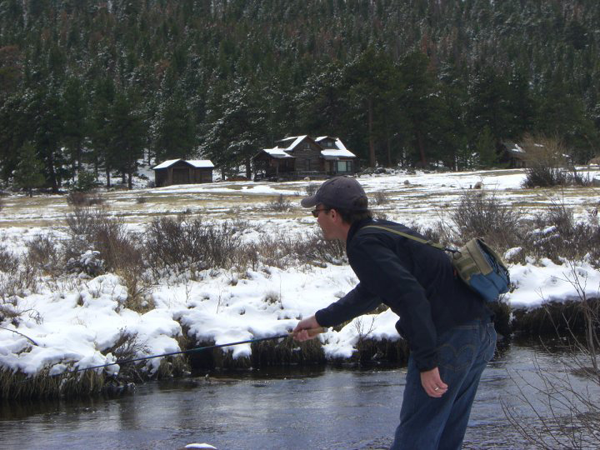
In winter, trout switch into a different mode from the warmer months of the year. And, you can’t blame them. After all, food is scarce, and their metabolism significantly slows down. This means two important things for the angler:
1. They will be more lethargic to conserve energy which changes their holding behaviours, patterns, and lies.
2. They employ a different approach to feeding to gain more energy in order to compensate for a leaner menu.
For lies, this means they’ll regulate by either favoring the more temperature-stable confines of deeper pools or sun-warmed stretches of calmer, shallower water where they can bask. But they still need food.
The instinct goes one of two ways: abundance of sparsity or gluttony of opportunity. Think of it this way. If you were really hungry at a really boring cocktail party and just wanted to fill your stomach, you could do one of two things–constantly nosh on small finger foods throughout the night, or gorge yourself on a larger entree and retire early. Both will work, though (depending on your hosts) you don’t know which option will be available to you before the party’s over. You’re kind of at the mercy of your host.
Trout do the same thing. The “host” is “the stream”. Available food sources change constantly so, they find themselves having to acclimate to the water temperatures, flows, insect activity, and other conditions and take advantage of whatever they can. Yet, if they want to eat at all, they have to be congenial. And winter (for trout) is no time to be a finicky guest.
While I admit that trout can seem especially fastidious in winter, I also think that we’re at an advantage as anglers since they’re also (although they are reluctant to admit it sometimes), somewhat desperate. So, if you want to catch trout during the sometimes challenging cold months, here are some confidence patterns I want to share with you. None of these patterns are groundbreaking by any means and you’re probably already familiar with some or all of them, but they have consistently worked for me so I think they’re worth a mention.
General Searching/Attractor Patterns
These are the patterns I use when probing unfamiliar waters or when I feel there are no “special conditions” that warrant special tactics or flies. They’re all scouting flies that aren’t necessarily intended to represent anything specific, but just look buggy and have a lot of appealing characteristics.
1. Simplified Bead-head Pheasant Tail Nymph
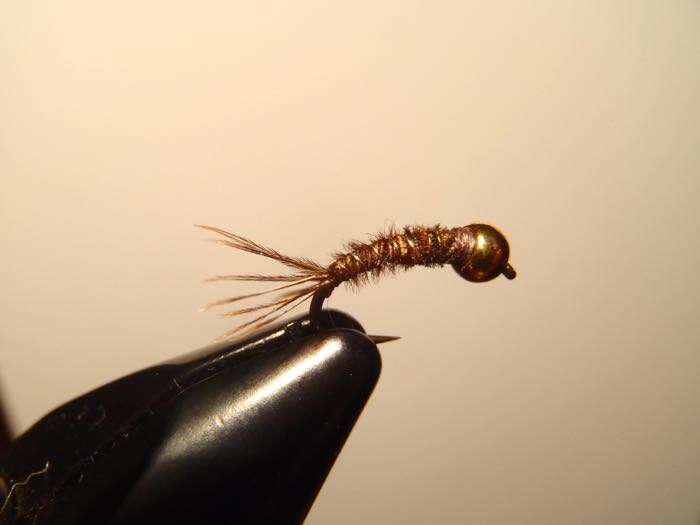
Hook: Tiemco 2457 #12-18
Head: Gold brass or tungsten bead
Thread: Camel or black UNI 6/0 to match body
Tail: 4-5 Black or natural pheasant tail fibers
Body: Black or natural pheasant tail
Rib: Fine gold wire
This is one of my go-to flies all year round but is also perfect for winter. It sinks well, is durable, and imitates a wide variety of aquatic insects like BWOs, midges, and caddis. But its most formidable quality is that it is cheap, simple, and fast to tie–meaning it’s expendable. I have no fear throwing it into the most gnarly log jams or against ice shelves where I just know a trout is hiding, but where I also know the angler before me didn’t want to risk losing their $4 Orvis fly. When the water is low and cold, try smaller sizes with a silver bead and wire instead of gold and black pheasant instead of natural.
2. Teeny Nymph
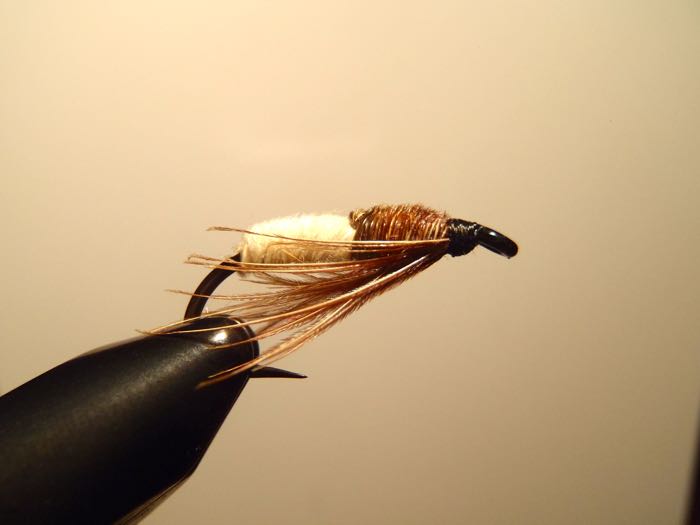
Hook: Any standard nymph hook #10-14
Thread: Your Choice
Body/Legs: Two clumps of 4-5 pheasant tail fibers in the color of your choice with the tips folded and wrapped back under the body after each stage. Click here for tying instructions.
I’ve written about this somewhat overlooked pattern in the past, but when one of the preeminent anglers in the world fishes it exclusively, you should probably at least give it a try. The Teeny nymph is a pattern I rediscovered from my early fly fishing days and continues to be a staple in experts’ boxes all around the world for a variety of species. It seems to work in just about every situation for just about every fish. For winter, I find all-black in smaller sizes to be most effective, but two-tone colors like the one pictured above work well too.
3. Black Flashback Pheasant Tail
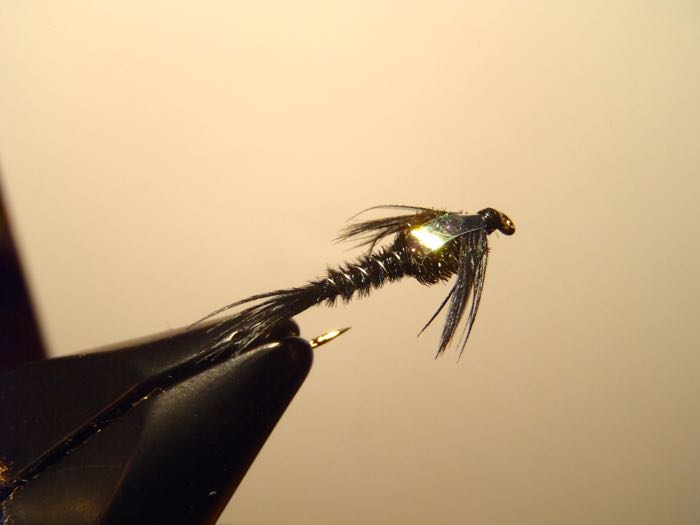
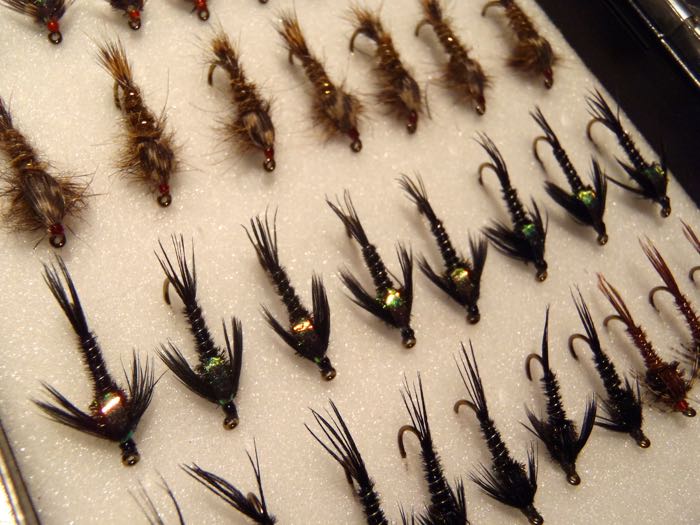
Hook: Standard nymph #12-16
Thread: Black 8/0 UNI
Tails: 4-5 black pheasant tail fibers
Rib: Fine silver wire
Abdomen: Black pheasant tail fibers wrapped
Thorax: Peacock herl or eye
Wingcase: Pearlescent Mylar
Legs: Black hen hackle
This is one I’m going to be a little more dogmatic about in terms of color and materials just because I’ve tried it so many different ways and this combo has reliably proven itself from New York to California; summer to winter. Black Stoneflies are ubiquitous and no matter the time of year they’re usually drifting along the substrate in some stage of their long underwater development cycle. Even though it might take a while for a stonefly nymph to mature, in their nymphal stages, they’re a still bigger and better protein source than #20 midges to the trout, right? So why not grab a big bite and chill out rather than work for 100 midges? Trout would rather have that big entree than a heap of finger foods when the opportunity presents itself.
4. Utah Killer Bug
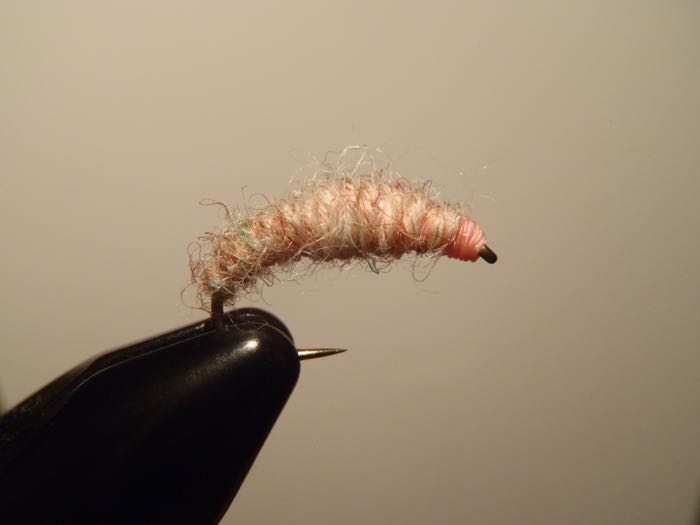
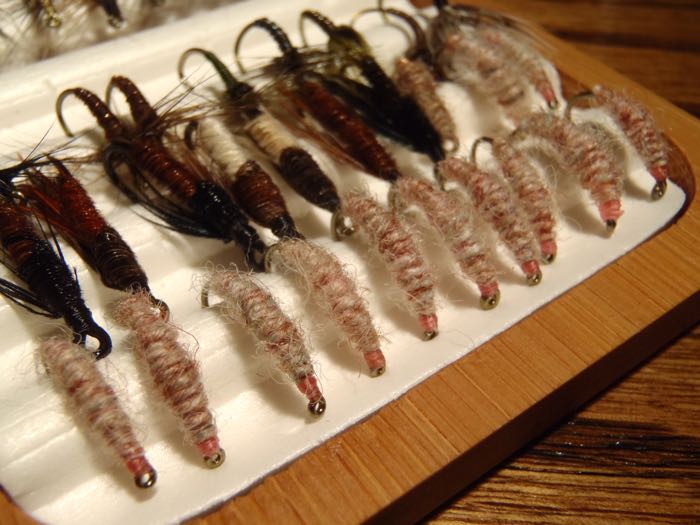
Hook: Tiemco 2457 #10-12
Thread: Pink 6/0 UNI
Underbody: Fine lead or tin wire wrapped only at the thorax (crest of the hook) to produce thoracic bulk.
Body: Utah Killer Bug Yarn twisted and wrapped
This is another one of my year-round go-to patterns. I will not hit any trout stream without it. The Killer Bug is one of those patterns that I almost (almost) feel guilty about using because it works so well. And like the pheasant tail, it’s a bigger, protein-packed meal. It could be a scud, it could be a caddis, it could be a grub. Who knows? All I know is that trout find it irresistible. Click here to see how I learned about the Killer Bug and how I tie my version of it.
Flies for Picky Eaters
Conventional wisdom says that “winter=small, black flies” and at this point, you might be wondering why I haven’t mentioned them yet. Yes, small flies do play a big part (but not every part) in a trout’s winter fare. So here they are …
5. The Glass Zebra Midge
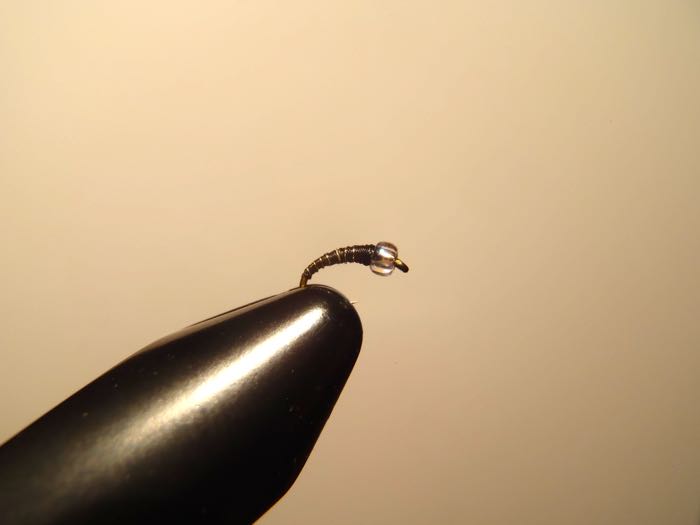
Hook: Tiemco 24987 #18-22
Bead: Clear, pearlescent glass bead
Thread: Black UNI 8/0
Body: Same as thread
Rib: Fine Silver wire
Back when glass beads first became a thing in fly tying, they weren’t available in any fly shop or fishing catalog. It happened organically. Some innovative anglers came up with the idea and it spread fast. The concept quickly became the same tour de force brass beads did when they first appeared on the scene in the 70s. I remember having to go to a bead shop (jewelry making store) to get them. But one thing was clear–they worked. Especially for small midge larva patterns. Today, you can buy all sorts of colors and sizes via fly-fishing retailers, but I still find bead shops offer a more diverse selection.
This fly is the epitome of the nondescript midge pattern. The Zebra midge is a pattern no numb fingers shouldn’t be able to reach for in the middle of a frigid stream. The original calls for a tungsten bead, but I like the clear glass to make a more delicate presentation to lazy fish in skinny water. It’s also a great dropper fly behind a heavier nymph like the bead-head pheasant tail if you’re fishing a two-fly rig.
6. The Epoxy Buzzer
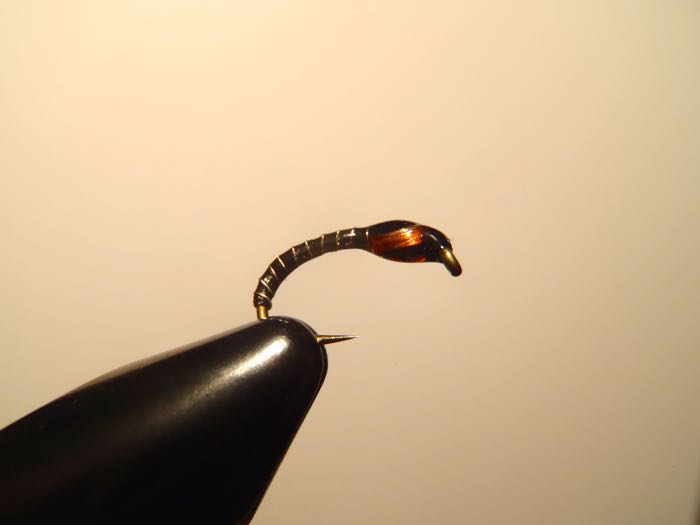
Hook: Tiemco 2457 #12-20
Thread: Black UNI 8/0
Body: Black UNI 8/0
Rib: Fine silver wire
Wing Buds: Orange Flexi-Floss
Head/Thorax: Back Thread
Coating: Coat the entire fly with 5-minute epoxy
In the U.K., midges are called “buzzers” and it usually refers to larger chironomids that live in reservoirs and stillwaters. There, the midges are huge compared to what we usually think of–size #12, #10, or even bigger. I first learned about buzzer patterns by reading some articles in stillwater fly fishing magazines from England years ago. One pattern that struck me was the black epoxy buzzer. It just looked sexy. I started out only using them in larger sizes in stillwater, but adapted them for moving water in smaller sizes. Epoxy isn’t everyone’s favorite to work with (and not mine either) but it does produce a good end result. The epoxy not only makes the fly look translucent, but adds a bit of weight and helps it sink hydrodynamically (not to mention making it bulletproof). And the ribbing gives it the buggy quality of segmentation while the orange wing buds add an attractor quality. Even if you don’t try this pattern in winter, if you fish stillwaters, wait until the thaw, tie a few up, and give it a shot from your float tube or from shore.
7. Blue-bead Midge
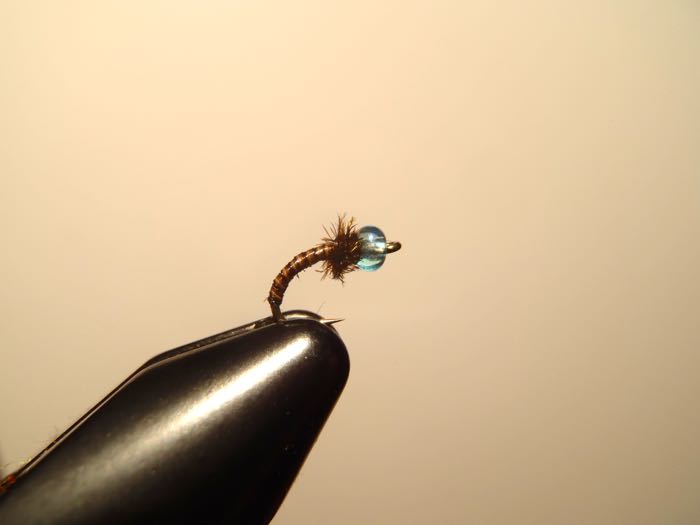
Hook: Tiemco 2488 #18-24
Thread: Black 8/0 UNI
Head: Light blue glass bead
Body: Stripped peacock quill
Thorax: Peacock herl
Honestly, I can’t exactly remember the inspiration behind this pattern. It was during the whole glass-bead craze that a small group of us were experimenting with microscopic midge patterns to fool the wiseguy, highly pressured browns on our local spring creek. I think one of the members of our unofficial tight-lipped society showed me some blue beads he got from the aforementioned bead shop and I took it from there.
The idea seemed outrageous at the time. I mean, a BLUE bead? But on the other hand, these fish had seen every pattern in the fly shop 100 times on any given day and wouldn’t relent. Could it hurt to throw something different at them and see what happens?
Well, we did just that. I empirically knew that contrast was an instinctive predatory trigger for most fish (including trout), so I asked myself, “what is the craziest contrast I can come up with that these fish have never seen before?” Then, it hit me. Do a totally illogical and unnatural blue bead with a totally natural and buggy looking body. So that’s why I opted for the natural peacock quill and herl body with the out-of-place blue bead.
On that spring creek, you could wade right up to a 20+” trout and it wouldn’t even bat an eye. In fact, they would just laugh in your face. But they took the blue-bead midge. It was always said by locals that if you caught even just one fish on that stream in a day, you’ve “graduated”. This fly was my cheat sheet. And I graduated with it.
8. The Brassie
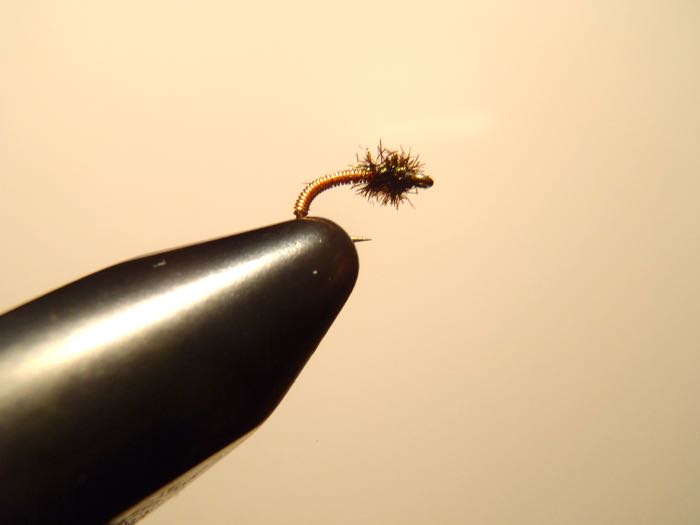
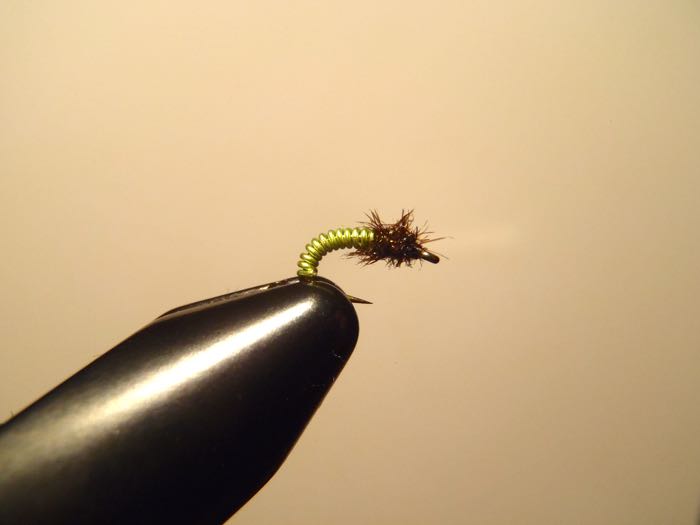
Hook: Tiemco 2488 #18-24
Thread: UNI 8/0 your choice
Body: Copper wire (color of your choice)
Head/thorax: Peacock herl
Brassie. It’s small, easy to tie, sinks well, durable, and versatile. Do I really need to say more? Just carry one.
Winter Dry Flies
Most people think that when the mercury drops, it’s the end of dry fly season. But this is simply not the case. Midges (and sometimes blue-winged olives) do hatch even in the dead of winter. And the trout will actively feed on the surface when the conditions are right. I’ve witnessed it enough times (and cursed myself for leaving all my dries at home enough times) to learn that I should always carry at least a couple of small dries with me even in January. Here are a couple of must-haves …
9. Griffith’s Gnat
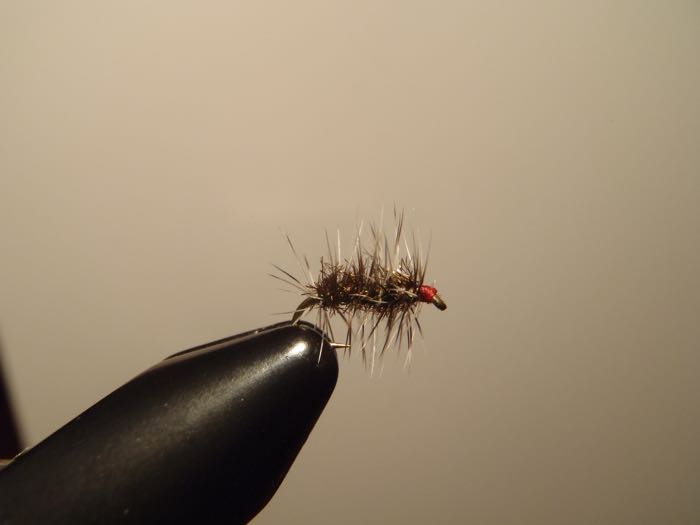
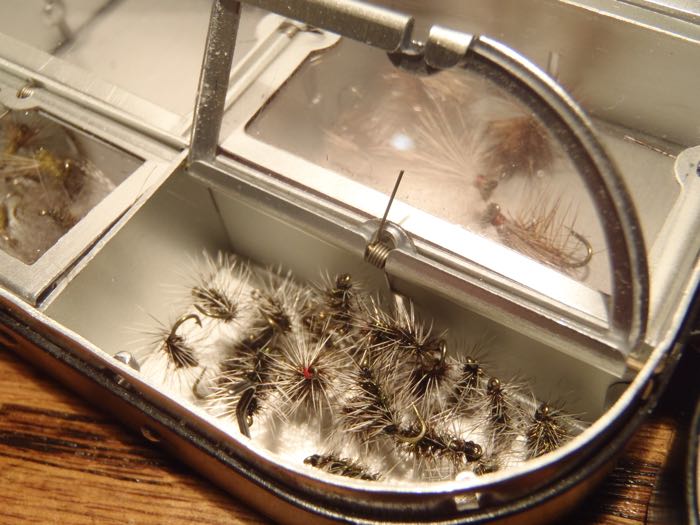
Hook: Standard dry fly #18-22
Thread: Black 8/0 UNI is standard but I prefer red
Body: Peacock herl
Hackle: Grizzly dry fly hackle palmered (one size under-sized)
What can I say about this venerable pattern? Probably every angler has one in their box. It could imitate a single midge or a cluster of several really tiny midges. I just think that its combination of iridescent peacock herl and variegated grizzly hackle screams fish food. I’d eat it if I were a trout. If you only carry one size, #20 is probably the best bet. Fish it on a 6X or 7X tippet and you’ll be able to make a good preso to any surface-feeding winter trout.
10. Palomino Midge
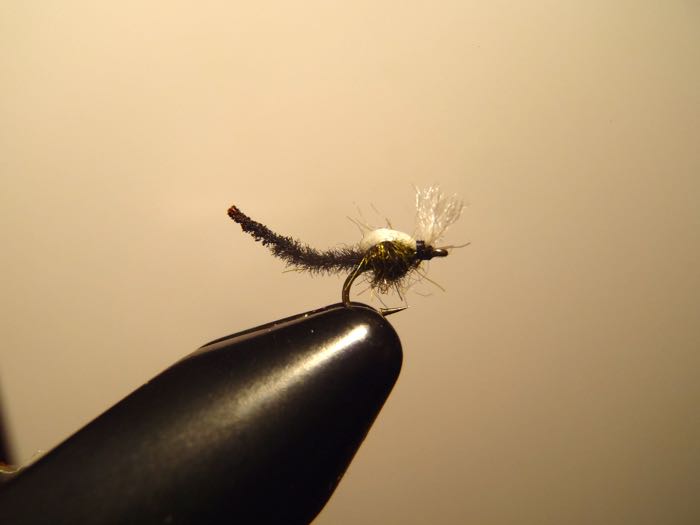
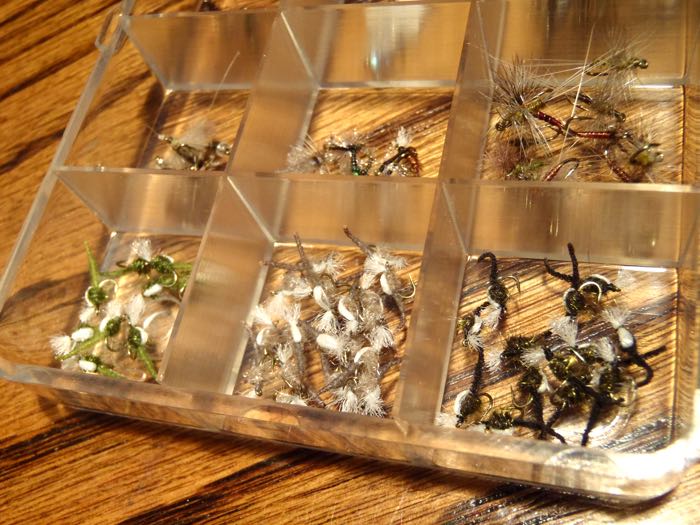 Hook: Tiemco 2488 #18-24
Hook: Tiemco 2488 #18-24
Thread: 8/0 color to match body
Body: E-Z Body extended over hook shank 3X the body length and singed with lighter to taper the tail end.
Thorax: Dubbing of your choice to match body or peacock herl.
Wingcase/breathers: White Antron yarn
Another staple that is a great producer when there’s a midge or BWO hatch. I typically use black but you can tie it in a range of colors. Despite it’s diminutive size, it’s still very visible against black winter water thanks to the white Antron “breathers” and wing case. You could also substitute hi-vis orange or red Antron if you’re having trouble tracking it in smaller sizes. Best fished with a 6X or 7X tippet in calmer, shallower waters or where top feeders are skittish.








Thanks for this compendium, Jason. I’ll admit to an almost total skunking during the wintry months along the Front Range, and while just being outside, knee-deep in a frigid stream, awesomely blue sky overhead, is a wondrous winter present, it would be kinda cool to occasionally bring in a wriggling trout. Plus, these patterns are a bit new to me – I remember your Teeny Nymph posting and how the simplicity really appealed. (Also, I’ve been having a ton o’ fun tieing (tying, tyeing?) variations of the Crackleback!)
Thanks Steve. Winter fishing in Colorado can definitely be tough, especially since the water gets so low along the Front Range (or too high after a snow melt). It’s difficult to catch the right conditions in between.
Using an egg pattern or bead head prince nymph and dropping off a bead head zebra midge is my standard set up for Winter fly fishing in with Tenkara. Usually the trout take the bead head zebra midge. The Browns spawned late in Utah this year and the egg pattern and bead head zebra midge worked well this winter as you can see in the following YouTube video called “Winter Nymph Fishing with Tenkara and Merry Christmas”:
https://www.youtube.com/watch?v=x4aN8LgHjjA
Utah Tenkara
https://www.youtube.com/c/UtahTenkara
Hope 2017 is better for you JK!
Tenkara Mark across the pond
As it is impossible for some flies to be bought from anywhere I guess it is great idea to invest in fly tying tools.
Thanks for the list! I just invested in some of the flies you listed! I have been fishing the marabou jig with a little luck (some of my catches below) but lately haven’t been able to get a fish. I use spinning rod/reel but bought a casting bubble – excited to try these flies out!
Also really want to give that Utah bug one a try but didn’t have it at my local store…any ideas where I could pick one up? Thanks!
I’ve seen them on Etsy and eBay. Also Tenkara Bum.